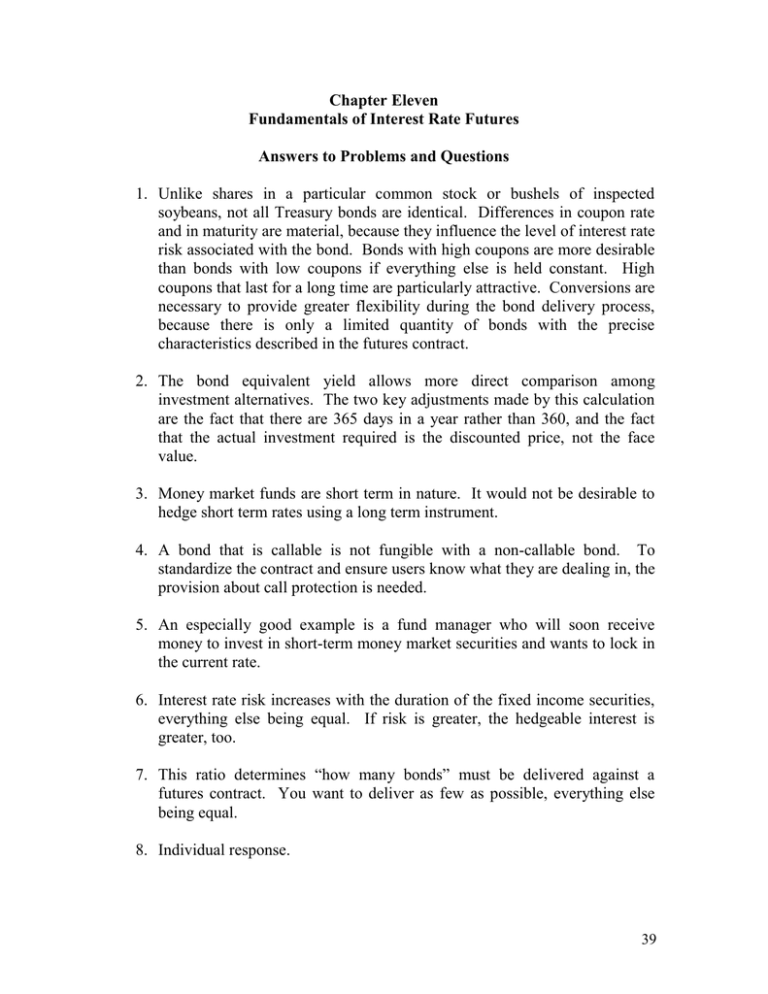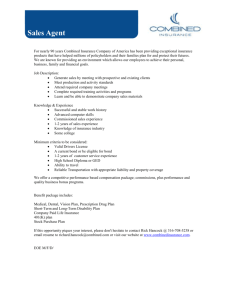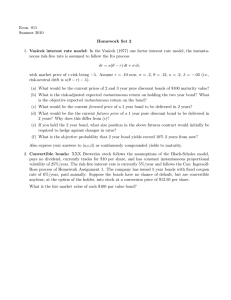Chapter Eleven Fundamentals of Interest Rate Futures Answers to Problems and Questions
advertisement

Chapter Eleven Fundamentals of Interest Rate Futures Answers to Problems and Questions 1. Unlike shares in a particular common stock or bushels of inspected soybeans, not all Treasury bonds are identical. Differences in coupon rate and in maturity are material, because they influence the level of interest rate risk associated with the bond. Bonds with high coupons are more desirable than bonds with low coupons if everything else is held constant. High coupons that last for a long time are particularly attractive. Conversions are necessary to provide greater flexibility during the bond delivery process, because there is only a limited quantity of bonds with the precise characteristics described in the futures contract. 2. The bond equivalent yield allows more direct comparison among investment alternatives. The two key adjustments made by this calculation are the fact that there are 365 days in a year rather than 360, and the fact that the actual investment required is the discounted price, not the face value. 3. Money market funds are short term in nature. It would not be desirable to hedge short term rates using a long term instrument. 4. A bond that is callable is not fungible with a non-callable bond. To standardize the contract and ensure users know what they are dealing in, the provision about call protection is needed. 5. An especially good example is a fund manager who will soon receive money to invest in short-term money market securities and wants to lock in the current rate. 6. Interest rate risk increases with the duration of the fixed income securities, everything else being equal. If risk is greater, the hedgeable interest is greater, too. 7. This ratio determines “how many bonds” must be delivered against a futures contract. You want to deliver as few as possible, everything else being equal. 8. Individual response. 39 Chapter Eleven. Fundamentals of Interest Rate Futures 9. No. If you hedge completely, you remove risk, and riskless positions will only earn the riskless rate of interest. For this reason, a policy of completely hedging 100% is not normally a good one. 10. Hedging, by definition, involves risk transfer. If you have already transferred all the existing risk, additional hedging really becomes speculation. 11. In your mind one bond may be preferable to another (as in the case of determining the bond cheapest to deliver). If this is the case, from your perspective the bonds differ in quality. 12. The timing option reflects the fact that the holder of a short position in Tbond futures can initiate the delivery process anytime during the delivery month. The wild card option reflects the fact that the holder of a short position may choose to initiate delivery up to six hours after the underlying T-bonds stop trading. 13. The T-bill is quoted at 92.33. This reflects a discount of 100% - 92.33% = 7.67%. The price of the bill is then $1,000,000 - x 360 x .0767 $1,000,000 91 Solving for x, the price of $1 million in T-bills is $980,612. 14. Buy @ 93.34. This indicates a yield of 6.66%. 90/360 x 0.0666 = .01665 $1 million/1.01665 = $983,622.68 Sell @ 93.40. This indicates rates have fallen to 6.60%. 90/360 x .0660 = .01650 $1 million/1.0165 = $983,767.83 There is a gain of $983,767.83 - $983,622.68 = $145.15 on each of four contracts, for a total gain of $580.60. 40 Chapter Eleven. Fundamentals of Interest Rate Futures 15. a) discount amount = $10,000 - $9,800 = $200 discount amount = face value x (days/360) x ask discount $200 = $10,000 x (88/360) x ask discount ask discount = 8.18% b) bond equivalent yield: discount amount 365 $200 365 x x 8.46% discount price days $9,800 88 16. Because there is only one cash flow with a zero coupon bond, its duration equals its maturity. 17. Using the CONVFACT excel file, we find the conversion factor for a 16 year, 7% bond is 1.1019. Invoice price = (settlement price x conversion factor) + accrued interest = (0.92 x $100,000 x 1.1019) + 0 = $104,680.50 18. 1.1926 19. 1.3555 20. The annual interest earned on $100,000 par of a 6.5% coupon bond is .065 x $100,000 = $6,500. Every six months the bond will pay half this amount, or $3,250. Midway through an interest payment cycle the bond will have accrued half this amount, or $1,625. The conversion factor on this bond (found using the CONVFACT file) is 1.0632. The invoice price is therefore (0.92 x $100,000 x 1.0632) + $1,625 = $99,439.40 21. The bond price is irrelevant. The conversion factor is 1.4078. 22. Individual response. The appropriate action is to buy 4 or 5 T-bill futures contracts now. 41 Chapter Eleven. Fundamentals of Interest Rate Futures 23. The annual interest earned on $100,000 par of a 9%% coupon bond is .09 x $100,000 = $9,000. Every six months the bond will pay half this amount, or $4,500. Midway through an interest payment cycle the bond will have accrued half this amount, or $2,250. The conversion factor on this bond (found using the CONVFACT file) is 1.3467. The invoice price is therefore (0.92 x $100,000 x 1.3467) + $2,250 = $126,146.40 24. The TED spread is a trade involving T-bill futures and Eurodollar futures, where one contract is long and the other short. Traders use this as a way to take advantage of anticipated changes in the global risk premium between short-term interest rates in the United States and in Europe. 25. One possibility would be increased tension in Europe, causing traders to believe that interest rates in Europe are likely to rise relative to those in the United States. Rising ED rates would cause Eurodollar futures to fall. To take advantage of this, someone might sell ED futures and buy T-bill futures. 26. The NOB spread, “notes over bonds,” is a way to take advantage of an anticipated change in the slope of the yield curve. For instance, a trader can sell the long end of the yield curve (selling T-bond futures) and buy the middle portion (buying T-note futures) if he or she believes that long term rates are going to fall more than intermediate term rates. 27. Individual response. The appropriate action is to buy 4 or 5 T-bill futures contracts. 28. Like the NOB spread, the LED spread is appealing to someone who anticipates a change in the slope of the Eurodollar yield curve or who believes there is a discrepancy in the existing Eurodollar rates and those implied in the forward rates. 29. The MOB spread, “municipals over bonds,” is a method for speculating on changes in the spread of taxable securities over non-taxable municipal securities. This spread periodically widens or narrows based on public sentiment, changes in tax laws, and the general economy. 42


